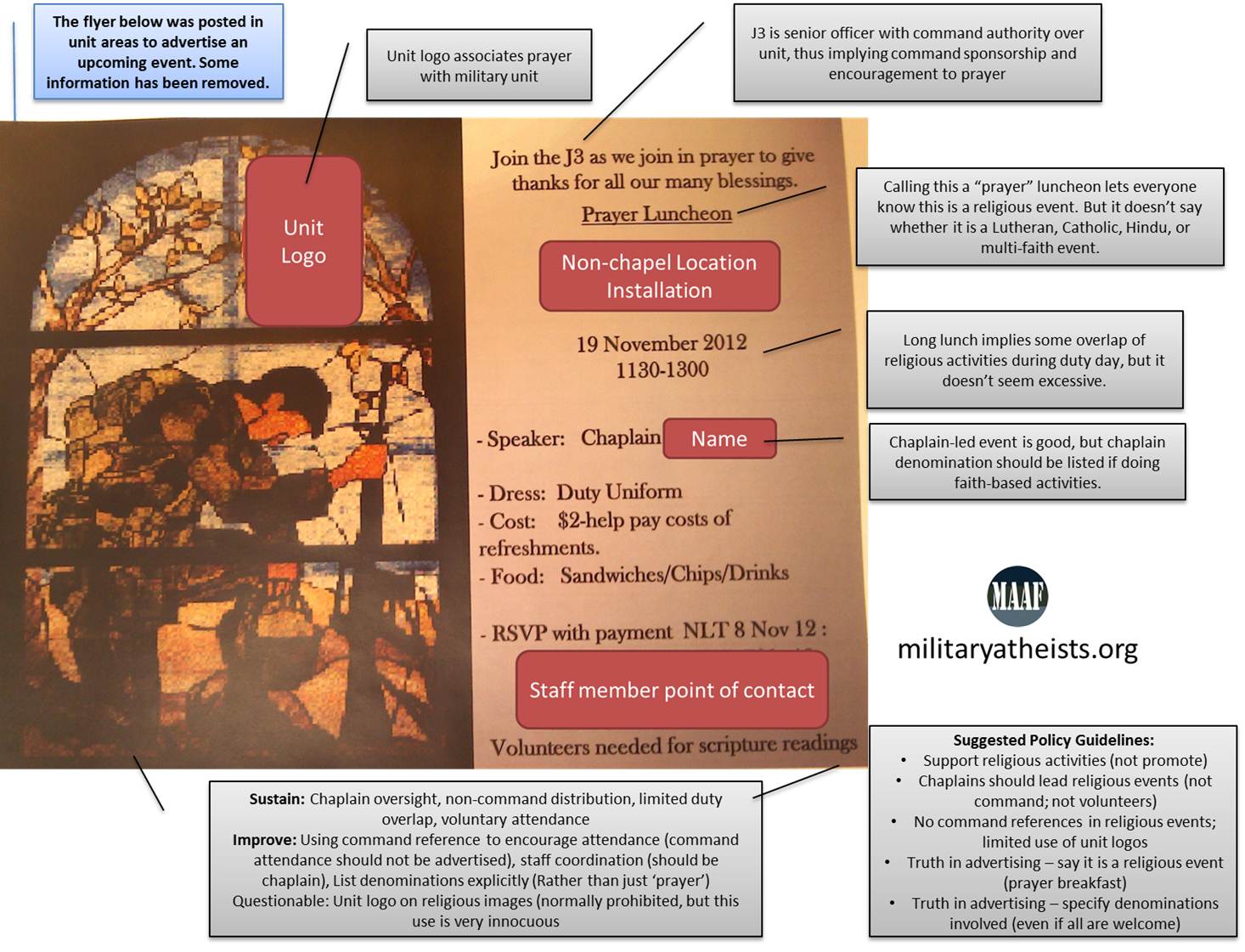Devil’s Advocate: Prayer Lunch Flyer
Devil’s Advocate is new recurring article regarding military policy. The focus will be on a specific incident reported to MAAF. The purpose will be to take the facts of an issue to create a vignette that can be used for decision-making by leaders and for training on what right looks like with respect to treatment of nontheists and mixing religion in official duties. Individuals involved should be protected by obscuring information while still providing enough information to learn for the future.
In this instance, a flyer was distributed around a unit office to advertise a “Prayer Luncheon”. A prayer luncheon is a legitimate activity to be organized and operated by the chaplain. Religious activities such as study of values and ethics, worship, meditation, and fellowship improve morale and increase resiliency so long as the events are handled properly.
There are several “red flags” in this flyer, including the use of the unit logo in religious imagery and the up-front advertisement that the “J3” will be featured at the event. The J3 is a senior officer and the “boss” for the military staff involved. Encouraging everyone to join the boss in prayer is a clear misuse of command authority to promote religious practice. This is not to say that the J3 or another commander could not attend the luncheon. The chaplain is the only leader who should be featured at a religious event as a host, featured guest, or speaker. Any more prominent participation by a commander or non-chaplain leader implies command sponsorship.
With respect to advertising, this flyer was distributed to the office. An email distribution also makes sense, but it should be from the chaplain and never from the commander or other non-chaplain command staff. The ideal method is to send the information only to those who have opted into a denomination-specific chaplain email distribution.
The use of the unit logo on the prayer image also overreaches boundaries but in a less extreme way. The image on the picture is not necessarily prayer except that it is advertised to be in a prayer luncheon and is in a church-like stained-glass format. It may be appropriate to have the logo listed somewhere if the unit chaplain is conducting an optional event for interested members of the unit, but it should not be too-closely associated with personal religious imagery. The use of unit logos on advertisements for sectarian events (or during sectarian events) should be done carefully to avoid official endorsement. Endorsement inappropriately privileges prayer and worship over more nontheistic beliefs and practices.
This flyer also does not clearly advertise the denominations that will be represented at the event. “Nondenominational” is too vague a term and often is a euphemism for Protestant or Fundamentalist Christian activities. There’s nothing wrong with doing a Protestant activity that is open to all, but the event should be advertised as such. “Chaplain-run” or “Nondenominational” or “Interfaith” isn’t really an honest when one Protestant chaplain will speak. That makes it “Protestant” and even that is a stretch if one doesn’t know whether it is Southern Baptist or Alliance of Baptists. If there will be leaders or clergy from, for example, Buddhist, Hindu, Jewish, and Protestant groups, then “Nondenominational” might not sufficiently represent broad diversity at an event. And going further, the chaplain may even sponsor an event with a humanist representative.
While a humanist could not authentically participate in “prayer luncheon”, we could participate in an “chaplain”, “values”, or “resiliency” luncheon. Humanists will differ personally, but most will feel welcome in an “interfaith” luncheon if a humanist leader is featured. While we don’t generally identify with “faith”, we are flexible with terminology so long as we are included explicitly. It would be improper to use “values”, “resiliency”, or other secular terms for a luncheon featuring clergy and prayer unless the religious component were prominently advertised. A “Thanksgiving Dinner” or “Holiday Party” should have no prayer or religious ceremony unless that is prominently advertised to avoid any surprises. And again, any religious event should be advertised only by the chaplain. A “Holiday Party” might be advertised by the command, but a “Holiday Party” with prayer or a “Christmas Party” should be advertised only by the chaplains.
The flyer that came out used the military command and unit logo to promote attendance at a prayer luncheon. That could have been easily avoided by removing the logo and removing reference to the commander. Another important change would be to explicitly advertise the denomination of any featured speakers or activities (Lutheran, Mormon, Hindu, etc) rather than implying “chaplain” or “prayer” is specific enough. However, those are extremely minor changes for what was for the most part an appropriate advertisement of a legitimate chaplain activity.

